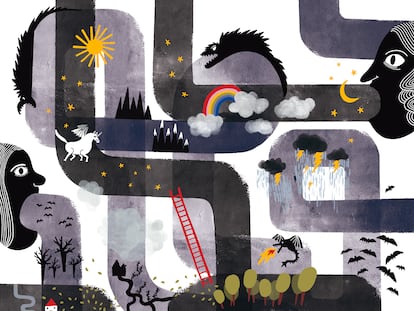It doesn’t make you stronger or teach you lessons: Making up reality with toxic positivity that damages mental health
People who use the tactic don’t mean to devalue or dehumanize the other’s experience, but they unintentionally end up making them feel silenced and misunderstood

Whitney Goodman begins her book Toxic Positivity by inviting the reader to imagine that, upon telling our friend we’ve lost our job, the other person offers a response as good-natured as it is harmful: “At least now you’ll have all the time in the world! It could be worse. Think about everything you’re going to learn from this”. It’s the moment, the author writes, in which toxic positivity makes its entrance.
We’re talking about advice that, although theoretically convenient to integrate into our lives, catches us unable to digest it in the moment in which it is offered. If that wasn’t enough, its attempt to lighten up a negative situation leaves us feeling silenced, judged and misunderstood. This phenomenon of subjecting a negative experience to a filter of optimism and vitality is known as whitelighting. Although the person who uses the tactic doesn’t mean to devalue or dehumanize the other’s experience, paradoxically that’s precisely what happens when someone tries to put a positive spin on negative or traumatic feelings and experiences experienced by another person.
Ana Ibáñez, author of Sorprende a tu mente (in English, Surprise your mind) explains that, on occasion, it can be hard for us to connect with the suffering of others and stay with that connection, which can leave us tempted to try to get them out of their situation the quickest way possible, instead of embracing or just being there for them. “There are a lot of well-intentioned attempts to help that skip over an important step, which is saying to the other person: ‘I understand: I understand what you’re feeling and I understand that it’s hard.’ Then, you have to pause and give the other person time. Maybe they’ll respond or maybe they won’t, but those words will surely help. Later, maybe we can offer ideas, but we have to be careful not to give unsolicited advice. It’s easy to offer it up when you’re not the one in the situation, but if it were that easy, it’s likely that the person would have found a solution on their own,” she explains.
Whitney Goodman, psychotherapist and owner of the Collaborative Counseling Center, a private therapy center in Miami, says that being sincere and authentic in moments of crisis or pain is important, and she underlines that when someone shows up authentically, instead of employing toxic positivity, they are validating that what the other person is experiencing is real. That way, they’re showing empathy, and not sugarcoating or denying their experience. In fact, the danger of denying what the other person feels is not insignificant. The study ¿Puede la positividad ser contraproducente cuando se sufre abuso doméstico? (Can positivity be counterproductive when someone is suffering from domestic abuse?) suggests that a toxically positive outlook can cause people to stay in abusive relationship, due to underestimating its harm. “We all have a certain aversion to feeling bad and it makes us uncomfortable to hear about negative aspects. Intellectually, we are called to try to fix things that aren’t going well, and the call can be even more intense if the person who is living through something negative is important to us and we have an emotional connection with them, because it activates the cerebral protection mechanisms related to loved ones. This is to say, the intention is not bad, it’s protective, but it doesn’t seem to be the best way to really help”, says Anabel González, author of ¿Por dónde se sale? Cómo deshacer el miedo, aliviar el malestar psicológico y adquirir un apego seguro (Where does that come from? How to get rid of fear, alleviate psychological distress and achieve a secure attachment). “The things that happen to us aren’t always positive and when we try to only see their good side, we’re overriding the possibility that things don’t turn out like we want them to, and become frustrated. It’s more healthy to move between positive and negative aspects, knowing that none of them are permanent and because of that, learning the mental techniques that help us to move on from negative aspects, because logically it’s healthier to live to focus on the positive aspects,” she adds.
The light from the dark side
New Age philosophy invites us to change our perception to navigate reality, but this road map can, on occasion, distance us from our lived experience and disconnect us from our own feelings, instincts and ultimately, from our own selves. As the neuroscientist Ana Ibáñez says, “to function well, we need to learn to navigate through the storms. Radical positive thinking doesn’t allow us to train ourselves in managing discomfort, something which is fundamental to be able to deal with the problems that life inevitably brings our way. It’s not about torturing ourselves with them, or going over them again and again, but you have to deal with problems head-on. When we don’t, we wind up complicating them. Positive messaging sounds very good, and it gets us followers on social media, but its solutions don’t last,” she explains to S Moda.
Even throughout the history of philosophy, the tendency has been to believe that life must be good and suffering avoided above all. Thinkers such as Aristotle have formulated theories of “the good life” that always defend the importance of striving for the best. Although we must, of course, keep striving when we encounter stumbling blocks, it’s important not to minimize or hide the sadness we feel. “Positive thinking rarely is as effective as a bandage when it comes to a gunshot wound. Instead of helping, it causes us to suppress emotions in a way that is destructive to our bodies, minds, relationships and society. Evidence clearly shows that suppressing emotions is inefficient and exhausting in the process of adapting. It can worsen one’s mood, increase negative feelings about social interactions, feed into continuous negative emotions, and even diminish any positive emotions that may be present”, writes Whitney Goodman in Toxic Positivity.
It’s becoming more common among books that look to guide the reader towards happiness to touch on the negative side of positivity, advising that only looking on the bright side of things doesn’t necessarily bring one closer to happiness and that in an unexpected twist, can wind up hurting us.
Ultimately, embracing sadness for a moment or even a certain, limited period of time can be, as Sara Ahmed writes in The Promise of Happiness, a form of political action, since pointing to the negative as a present in progress is always an affirmation. As the author says, we should and we can ruin the party. If in her song It’s My Party, Lesley Gore defended the right to cry in one’s own féte, shouldn’t we have the right to cry or complain in our own lives?
Sign up for our weekly newsletter to get more English-language news coverage from EL PAÍS USA Edition
Tu suscripción se está usando en otro dispositivo
¿Quieres añadir otro usuario a tu suscripción?
Si continúas leyendo en este dispositivo, no se podrá leer en el otro.
FlechaTu suscripción se está usando en otro dispositivo y solo puedes acceder a EL PAÍS desde un dispositivo a la vez.
Si quieres compartir tu cuenta, cambia tu suscripción a la modalidad Premium, así podrás añadir otro usuario. Cada uno accederá con su propia cuenta de email, lo que os permitirá personalizar vuestra experiencia en EL PAÍS.
¿Tienes una suscripción de empresa? Accede aquí para contratar más cuentas.
En el caso de no saber quién está usando tu cuenta, te recomendamos cambiar tu contraseña aquí.
Si decides continuar compartiendo tu cuenta, este mensaje se mostrará en tu dispositivo y en el de la otra persona que está usando tu cuenta de forma indefinida, afectando a tu experiencia de lectura. Puedes consultar aquí los términos y condiciones de la suscripción digital.
More information
Últimas noticias
Most viewed
- Sinaloa Cartel war is taking its toll on Los Chapitos
- Oona Chaplin: ‘I told James Cameron that I was living in a treehouse and starting a permaculture project with a friend’
- Reinhard Genzel, Nobel laureate in physics: ‘One-minute videos will never give you the truth’
- Why the price of coffee has skyrocketed: from Brazilian plantations to specialty coffee houses
- Silver prices are going crazy: This is what’s fueling the rally











































